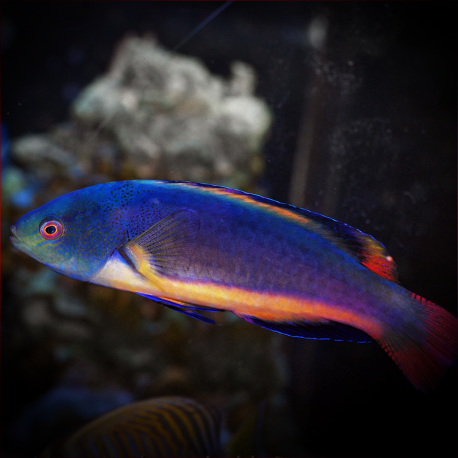More info
Datasheet
| Minimum Tank Size | 400 litres / 105.67 US gallons |
| Maximum Size | 13.0cm / 5.12inches |
| Reef Compatible | Always reef safe |
| Temperament | Might be aggressive towards similar species of same gender |
| Temperature | 22.2°C / 71.96°F - 25.6°C / 78.08°F |
| Specific Gravity | 1.020-1.025 |
| Carbonate Hardness | 8-12 |
| pH | 8.1-8.4 |
General Description
The Scott's Fairy Wrasse, scientifically known as Cirrhilabrus scottorum, belongs to the Labridae family. These fish are characterized by their vibrant colors, with variations based on their origin. They can change gender from male to female and vice versa, with males displaying color flashes during courtship. Scott's Fairy Wrasse is commonly found in the Pacific Ocean, from the Great Barrier Reef to the Pitcairn Group, and can grow up to 13.0cm.
Aquarium Suitability
Scott's Fairy Wrasse is suitable for most aquariums but may exhibit aggression towards similar species of the same gender. They require a tank of at least 400 liters, with ample hiding spaces among live rocks. When introducing them to the aquarium, ensure a peaceful environment to aid in acclimatization. These fish are sensitive during transportation and acclimatization, necessitating careful handling.
Demands, Care, and Hardiness
With an average hardiness level, Scott's Fairy Wrasse needs frequent feedings, especially when newly added, and prefers a varied diet including small crustaceans and zooplankton. They are active swimmers and require plenty of space in the aquarium. It is recommended to feed them multiple times a day to maintain their health and coloration. Inspecting their mouth area for injuries and monitoring their activity during feeding is crucial for their well-being.
Reef Suitability
Scott's Fairy Wrasse is considered reef-safe and is often seen in reef aquariums due to their vibrant colors and compatibility. They can help control unwanted invertebrates, making them valuable additions to reef ecosystems.
Aquarium Setup
Setting up the aquarium for Scott's Fairy Wrasse involves providing ample swimming space, hiding spots among live rocks, and a secure lid to prevent jumping. Introducing these fish simultaneously or adding females first is advisable, especially when keeping multiple individuals. Maintaining stable water conditions with a pH of 8.1-8.4, a specific gravity of 1.020-1.025, and a temperature range of 22.2-25.6°C is essential for their well-being.
Behaviour
These wrasses may initially hide when introduced to a new environment but will become more active once acclimated. Males can display rough behavior towards each other, making it important to monitor their interactions. Scott's Fairy Wrasse, like other wrasses, may form a mucus cocoon between rocks for sleeping.
Feeding and Diet
Feeding Scott's Fairy Wrasse a varied diet of frozen and flake foods multiple times a day is necessary to maintain their health and coloration. Their diet should include small crustaceans like krill and zooplankton such as mysis and artemia.
Dimorphism
There is a significant color difference between male and female Scott's Fairy Wrasse. Males can change colors during courtship, adding to their striking appearance. The species is hermaphroditic, with females changing sex to males when necessary. Captive reproduction of Scott's Fairy Wrasse may involve gender changes in response to environmental conditions.
Habitat and Distribution
Native to regions like Australia, Japan, and Indonesia, Scott's Fairy Wrasse inhabits the East Pacific and Central/West Pacific areas. They are commonly found in reef environments from the Great Barrier Reef to the Pitcairn Group, where they contribute to the ecosystem's balance by controlling invertebrate populations.

